
To use this site, please enable javascript

To use this site, please enable javascript
Returning to sea with hardware refinements, the EIVA ScanFish XL has demonstrated its capability to deliver superior performance on subsea survey operations compared to work class ROV solutions across key metrics including speed, cost and payload capacity
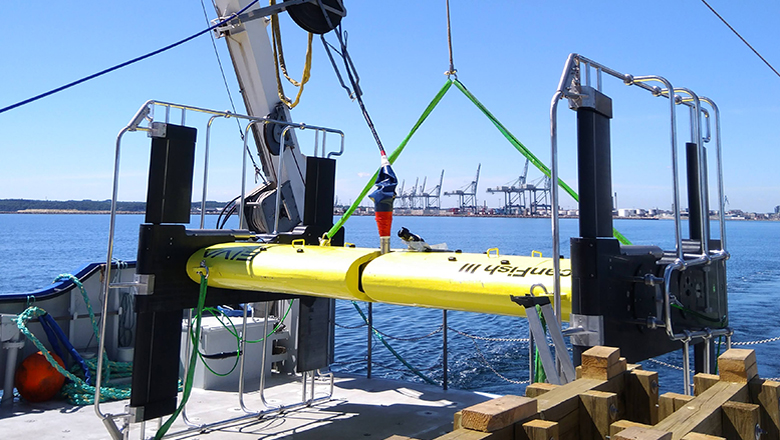
ScanFish XL was officially introduced in December 2017 as the largest and newest addition to EIVA’s family of ScanFish remotely operated towed vehicles. The vehicle measures 4.33 x 2.73 x 2.77 metres and weighs a mighty 1840 kg on land.
The largest and newest addition to EIVA’s family of ScanFish remotely operated towed vehicles (ROTVs), ScanFish XL’s latest sea trials took place in late June in the summery waters of Aarhus Bay. ScanFish XL’s performance indicates that the subsea survey platform will not only enable reduced vessel time and lower survey costs, but also conditions supporting enhanced data collection.
Operating at survey speeds of 3-4 knots, ScanFish XL is at least three to four times faster than a work class ROV. Nevertheless, despite its ability to work at speed, with very low roll and pitch, the inherent high stability of ScanFish XL makes it an ideal platform for sensors and instruments sensitive to unwanted movements, such as synthetic aperture sonar. These characteristics mean that ScanFish XL can secure swift, high quality data collection without compromise.
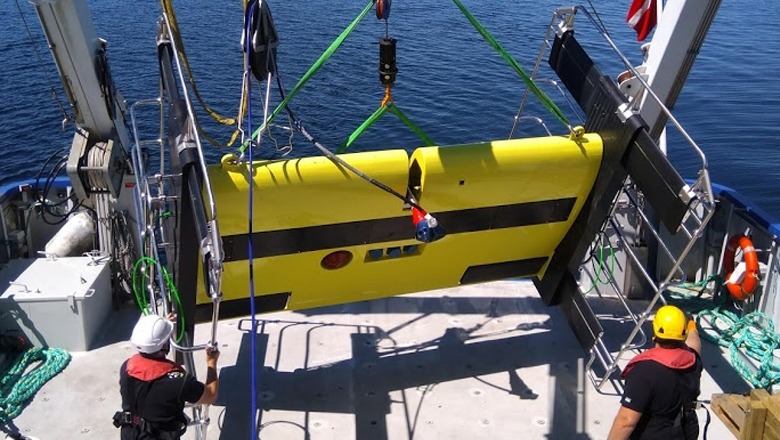
EIVA ScanFish XL is lifted off of the deck of research vessel AURORA, and deployed with well-rehearsed precision.
‘The idea with the tests was to press the system to the limit. It is designed for an operational speed of 6 knots, but in our tests we were running at 9 knots for a period with good results, a stable system and good responses,’ reported Martin Kristensen, EIVA Hardware Development Manager, who was on-board the research vessel AURORA to supervise the trials.
The high payload capacity at low system cost of ScanFish XL is another compelling benefit of the system. The ScanFish XL unit under evaluation has been outfitted to host a 350 kg 3D SAS Sub Bottom Imager (SBI) from marine geophysical-geotechnical service delivery specialist PanGeo Subsea.
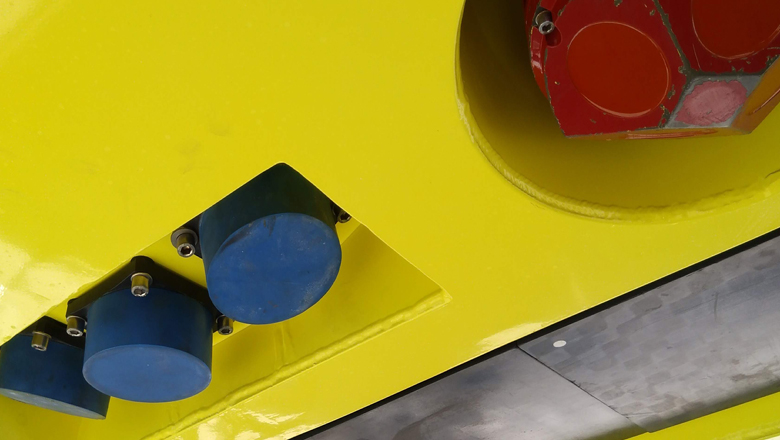
ScanFish XL has been customised to meet requirements of PanGeo Subsea. Shown here, the underside of ScanFish XL reveals components of the Sub-Bottom Imager system that was under evaluation by the company.
Compared to a work class ROV, which would be the alternative platform for carrying the weighty PanGeo SBI, ScanFish XL is about a tenth the cost.
‘The XL is able to carry up to 500 kg of hardware, that’s an increase of 900% compared to the 50 kg payload of the original EIVA ScanFish models. Payload capacity at that scale really opens up opportunities for surveyors,’ said Kristensen.
Reflecting on the sea trials’ outcomes, Jeppe Nielsen, EIVA CEO, said: ‘The ScanFish XL was designed and built by EIVA’s hardware research and development team in a very short time frame. It has now demonstrated its ability to carry advanced payloads, such as the PanGeo SBI, and we are looking forward to bringing this platform forward to commercialisation and into real projects delivering further cost reductions for UXO and cable route surveys.’
Of interest to EIVA technicians during the trials was ScanFish XL’s performance whilst executing movements across three dimensions — manoeuvres enabled via manipulation of the vehicle’s vertical and horizontal flaps.
With this feature, customers will not only be able to control the vertical position of their sensors in the water column, but also benefit significantly from the capability of controlling the sideways movements of the ROTV as well.
Performance of new motors fitted to the ScanFish XL since its last sea excursion was therefore under close observation as operators sought to test the design standards of ScanFish XL whilst operating with high speed runlines.
All told, we are happy to report that the ScanFish XL system performed excellently, and line steering with 3D autopilot – configured to follow the seabed and remain on runline – proved wholly successful.
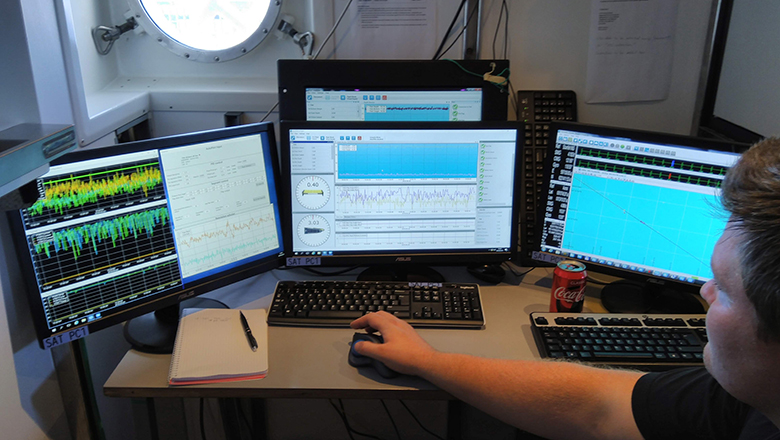
EIVA crew monitor performance of ScanFish XL, whilst adjusting its movements to meet navigational parameters required by the PanGeo team.
The sea trials were arranged in collaboration PanGeo Subsea, which is taking delivery of the first ScanFish XL unit. Outfitted with its 3D SAS SBI, PanGeo Subsea will market the ScanFish XL as the SBI SeaKite — a platform designed to deliver a more cost effective multi-sensor towed solution for pre-route and UXO surveys.
Seeking to evaluate performance of their SBI, PanGeo personnel travelled to Denmark from as far as Canada and Scotland for the trials.
Moya Cahill, PanGeo Subsea’s President & CEO, said: ‘We are very excited with the launch of our SBI SeaKite. The SeaKite has taken the attributes of EIVA’s 3D ScanFish and PanGeo’s 3D SAS SBI and created an active towed robotic system that will revolutionise seabed survey.’
Commenting on the value of developing upon the proven ScanFish platform, Cahill said: ‘We have scaled up the ScanFish creating an XL version that accommodates our SBI hydrophones, projectors and bottles internally in its wing. This keeps our SBI configuration ‘as is’, thereby enabling us to continue to deliver with confidence high resolution, 3D imaging of cables, as well as ferrous and non ferrous UXOs to depths of 5-7 meters.’
Cahill continued: ‘The larger wing offers additional payload and real estate to accommodate other sensors, such as multi-beam, side scan sonar, magnetometers, video etc. This enables us to collect data from multiple sensors in one pass, eliminating positional error and reducing survey time.'
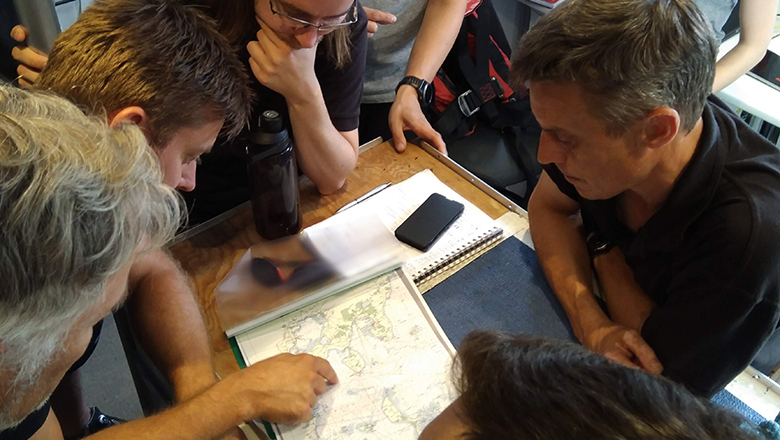
Reviewing the day: EIVA and PanGeo Subsea team members review the charts after a successful first day of sea trials.
With various system calibrations completed on day one, on the second and third days of the sea trials operators of ScanFish XL sought out unexploded ordnance known to reside at the bottom of Aarhus Bay, as well as demonstrated the system’s ability to find and follow cables.
Cahill remarked on the events: ‘The trials that we have completed with EIVA this past year have proven the SeaKite to be a very stable and responsive platform. Its active steering feature enables us to control altitude and maintain runline well within our operating parameters. We have doubled the SBI’s ping rate to deliver improved contrast, resolution and clarity at higher speeds on smaller vessels.’
‘We are looking forward to delivering faster and more cost effective pre route and post laid survey solutions for 2019,’ concluded Cahill.
The trials were conducted from Aarhus University’s research vessel, AURORA, with which EIVA enjoys a great partnership. EIVA would like to extend its thanks to the crew of AURORA for their support throughout the trials – we look forward to the next time!
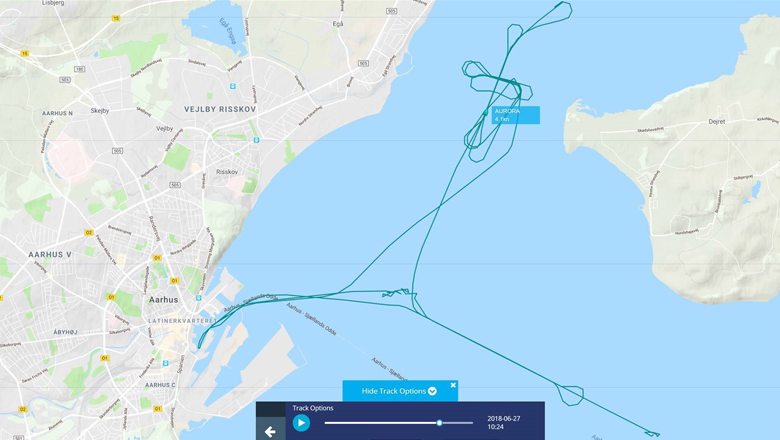
The course charted by AURORA across the three days of sea trials in Aarhus Bay. Screen-capture collected via MarineTraffic.
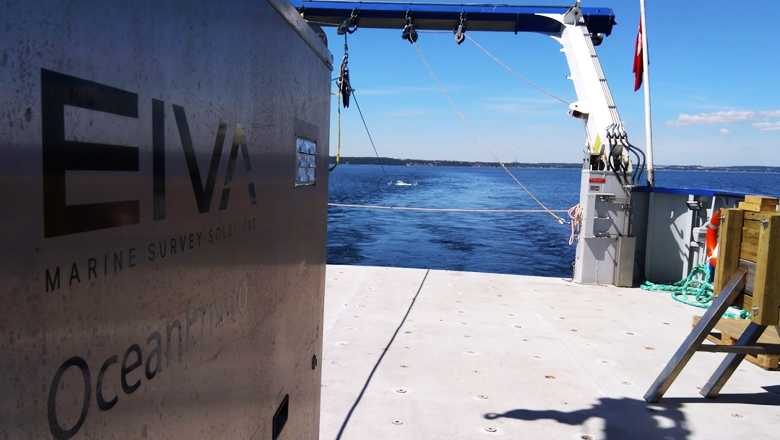
ScanFish XL is put into position with the help of the OceanEnviro winch.